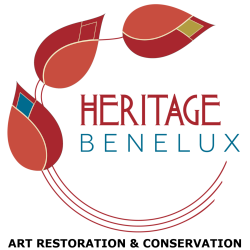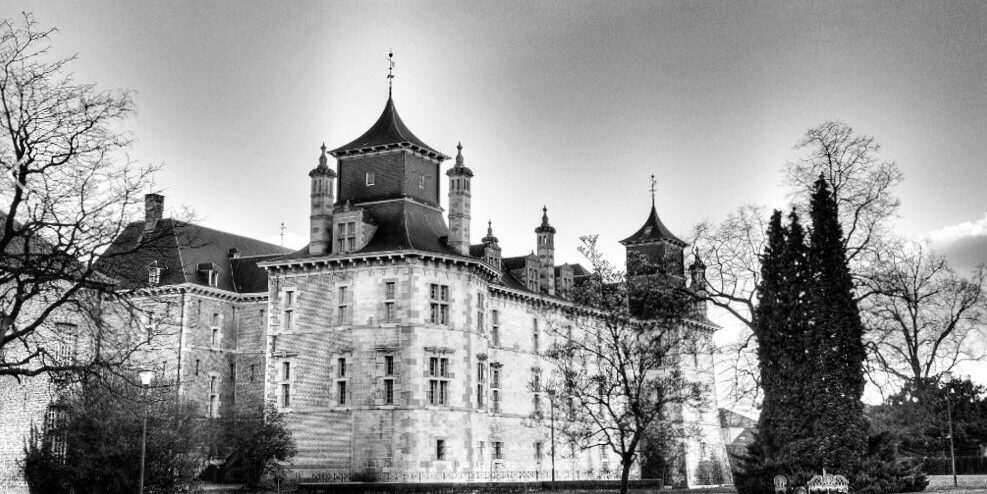
The castle is located within the enclosure of the asylum, and occupies the entire city area between Kanaalstraat and Onder De Linden; now accessible via the late 19th-century administrative buildings on the Groenplaats side. A small portion of the original moat, to the south and west, at the foot of the walls has been preserved. Four wings of the original water castle have been preserved, with a tower at each corner, grouped around a small courtyard; access to the original complex was immediately north of the present northwest tower. The vanished buildings extended north and east of the present castle, so that the current north and east wings lay between the other buildings, while only the west and south facades were outer walls, which can now be seen in the use of marl stone for these walls, while the inner walls were built in brick.
Within the enclosure of the psychiatric institution are also the early 19th-century hospital buildings, the director’s house from the beginning of the 20th century, the platform of Rekem and a corner tower of the first enclosure.
The west wing has two corner towers, the north corner tower, five-sided, the south rectangular; gable roof (slates) with six marl-stone roof windows: cross frames lined with an entablature with medallions and spiral motifs; marlstone chimney. The west facade is a marlstone cornice facade of seven bays and three storeys on a limestone plinth. Horizontal facade articulation through the cordon-forming limestone leakage thresholds of the windows. On the first storey, small, rectangular windows in a flat limestone frame with four slightly protruding bush-hammered neg blocks; on the second storey, limestone monastery frames with neg blocks, and a strongly protruding, profiled drip molding with a bush-hammered keystone; on the third storey, limestone monastery frames in a flat frame with regularly spaced neg blocks; between the upper windows, on the cordon, slit-shaped limestone loopholes. Wooden cornice on elongated, sculpted modillons; below a slightly protruding, sculpted, marl stone band with licorice motif; between the modillons a frieze of diamonds and medallions.
The towers are also of marlstone, with limestone corner bands, plinth and cornice, and the same horizontal articulation as the west facade. Curved tent roof (slates), on which a square, wooden and slate-covered construction, in turn also surmounted by a curved tent roof; beautiful, forged iron wind vanes, on the northwestern tower decorated with the double-headed eagle of the German Reich, on the southwestern tower with the year 1769, double-headed eagle and the lion of Rekem; the roofs are also fitted with skylights and chimneys. The lower windows are like those on the west facade; in the northwestern tower on this storey are a series of loopholes with a round opening in the middle; the two upper floors of the south-west tower have wall openings as in the west facade, the north-west tower has cross frames, finished like the monastery frames of the west facade. Halfway along the north facade of the northwest tower, there are a series of loopholes with a round opening in the middle on this storey; the two upper floors of the south-west tower have wall openings as in the west facade, the north-west tower has cross-frames, see the monastery windows of the west facade. The division between the marl stones and the brick part of the building runs halfway along the northwest facade of the northwestern tower; probably the enclosure wall connected to the castle here.
The south wing is also flanked by two corner towers: the above-mentioned southwest tower, and the southeast tower. Hipped roof (slates), with nine marl stone roof windows. Marlstone south facade of nine bays and three storeys, in terms of design and finish like the west facade. Limestone cross-frames on the top floor, limestone spherical frames on the ground floor with bush-hammered, protruding Narrow blocks. The southeast tower has a roof with roof windows and chimney; the south facade is provided with cross frames, the east facade with monastery frames.
The north wing is covered with a gable roof (slates) with dormer windows. The current entrance is located in the north facade; the two corner towers are conceived here as strongly protruding corner risers, flanking the centrally placed entrance gate; brick construction of two bays (north façade of the northeast corner tower) + one bay (west façade of the north-east corner tower) + three bays (north façade) + two bays (east façade of the northwest corner tower) + two bays (two brick bays from the north façade of the northwestern corner tower), and two storeys; highly elevated ground floor, with high limestone plinth, except at the northeast corner of the right corner tower; wrought iron wall anchors with curls. Limestone corner tires and cordon-forming limestone puncture sills. Wooden cornice on profiled wooden modillons, with a slightly protruding marlstone band underneath. Windows (cross and monastery frames) as described above; if these wall openings are not finished with drip strips, they are provided with a relief arc of two roller layers. The portal is round-arched, in a checkered and bush-hammered, rectangular frame of bluestone; heavy entablement with triglyphs and open frieze, crowned by a profiled drip strip; hard stone facade with double quarter-turn stairs. The northeast corner tower, under the hipped roof (slates), is finished like the other facades.
The east wing, together with the adjoining southeast corner tower, form an L-shaped whole, built in brick; gable roofs (slates) with particularly beautifully finished, marl stone roof windows (panes, medallions, coats of arms with the cross of the Lynden family, wing pieces and lilies). The south façade of the southeast corner tower has five bays, the east façade seven bays, each two storeys on a highly elevated ground floor with limestone plinth, fitted with cellar windows and doors, finished with bush hammered negblocks. Ordinance and finishing such as the north side. All windows here are cross-framed, fitted with heavy, profiled drip strips; for the rest, see above; the two lower right windows of the south side wall were later (?) converted into doors.
The courtyard is a small, roughly rectangular space. The different brick facades have two storeys; wrought iron wall anchors with curls; wooden cornices on profiled modillons with marl stone band underneath; the roofs are equipped with skylights and dormer windows. The upper floors are provided with identical wall openings: limestone cross-frames with neg blocks, rebate course, profiled sill and drip strip; cordon-forming leak barriers (all-round); relief arc of two roller layers. The north facade has five bays on the ground floor and three on the top floor; on the ground floor there are two rows of small, rectangular limestone windows, with neg blocks, rebate and relief arch made of two roller layers and a flat layer. Later added (?), Rectangular door with neg blocks and drip molding.
The east facade has five bays; in the facade there are three facing bricks: on the left, a facing brick with an image of an urn, dated 1603 and inscription: HIC IACET COR GENEROSI DNI HERMANI DE ASPRE. LYND; in the center a facing stone, applied by the Belgian state, referring to repairs and renewals, carried out in 1903 and 1911; on the right, a stone with the Lynden family’s coat of arms and dated 1597. The lower windows of this facade are former cross-frames, from which the cross has disappeared.
The south facade has five bays; in the middle a beautiful gable stone with the coat of arms of the d’Aspremont-Lynden-Rekem family; the title “count of Rekem” was granted to the family from 1623; since then the lion of Rekem has been added to the family’s coat of arms; this gives a terminus post quem for this facing brick. The ground floor is open by means of a limestone round-arch arcade, with doors in the two outer arches, the other arches have windows, on a limestone plinth with panel; profiled pedestals and imposts, and three keystones per arch, with diamond-headed motif; this arcade was originally open, the woodwork is a later addition. The west side is longer than the other sides (seven bays); in the center a facing brick with inscription: POSTCRITATE / IMP.RUDOLPHUS II CAES. GER. P.F. AUG./ Cum Baronatum Imperii hunc veterem aevo et bello / Lapsum attritumque audiret / Ut is in pristinum splendorem dignitatemque / posset restitui / HERMANO / ex comitibus de Aspremont / Lynden Domino horum / locorum et Baroni benigne concessit indulcitce / immediat utnia utnia. Rom.Imp / Baronatus / iura, regalia, immunitates, privilegia / Signa vetustas fish, fraus delevisset, oppressisset, intervertisset / ea omnia restituerentur, redderentur / utiquo optimo iure ante fuissent / ob haec indulta et beneficia caesarea excitatus / idem Hermanus / hermanus labentem aut lapsam / ex ovali in meliorem maioremque hanc formam / redegit, extruxit a fundamentis innovavit / cum mesaulis hypaethris et adnunctis aedificiis / POSTERITAS / hoc scire te in full et quisquis haec leges / Anno Dom MDXCVII (1597). The ground floor has a round arch arcade, like the south façade, but with alternating a seeing and a blind arch.
Interior: hardly any traces of the original interior have been preserved, following the redesign of the building in the 19th century and at the beginning of the 20th century. Only those of the towers of the original oak roof structures have been preserved, the other roofs were rebuilt with metal structures.
Hospital buildings, rising at the core until the early 19th century, but greatly adapted during the redevelopment.
In the garden is the platform of Rekem: a limestone column on a rectangular plinth, crowned with a lion, holding the coat of arms of the Counts d’Aspremont-Lynden-Rekem.
In the same garden is also a small tower of the first fortress, on the forged iron weather vane dated 1607. Square, brick tower under tent roof (slates); raised ground floor; diagonal mouse tooth frieze under the eaves. Original narrow limestone wall openings (loopholes); the door and windows of the ground floor are later additions.
Directors residence: Detached villa with complex shape, now abandoned and situated in a neglected garden. Erected 1904-08; the style is a mixture of time-bound elements with style elements, inherited from the castle (windows, dormers, chimneys, and others). Yellow brick building with bluestone finish (plinth, bands, window frames). Mansard roofs (slates) with forged iron crowns. The windows are coupled monastery frames with high-placed sill. Beautiful wooden portal with an Art Nouveau touch.

